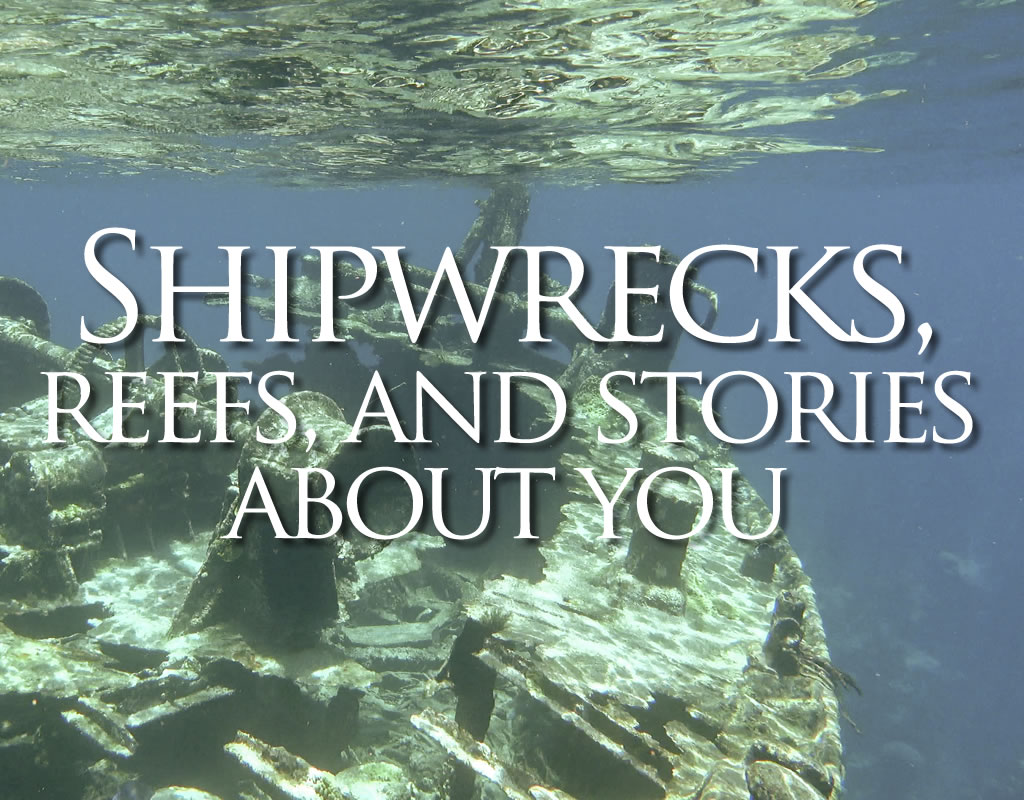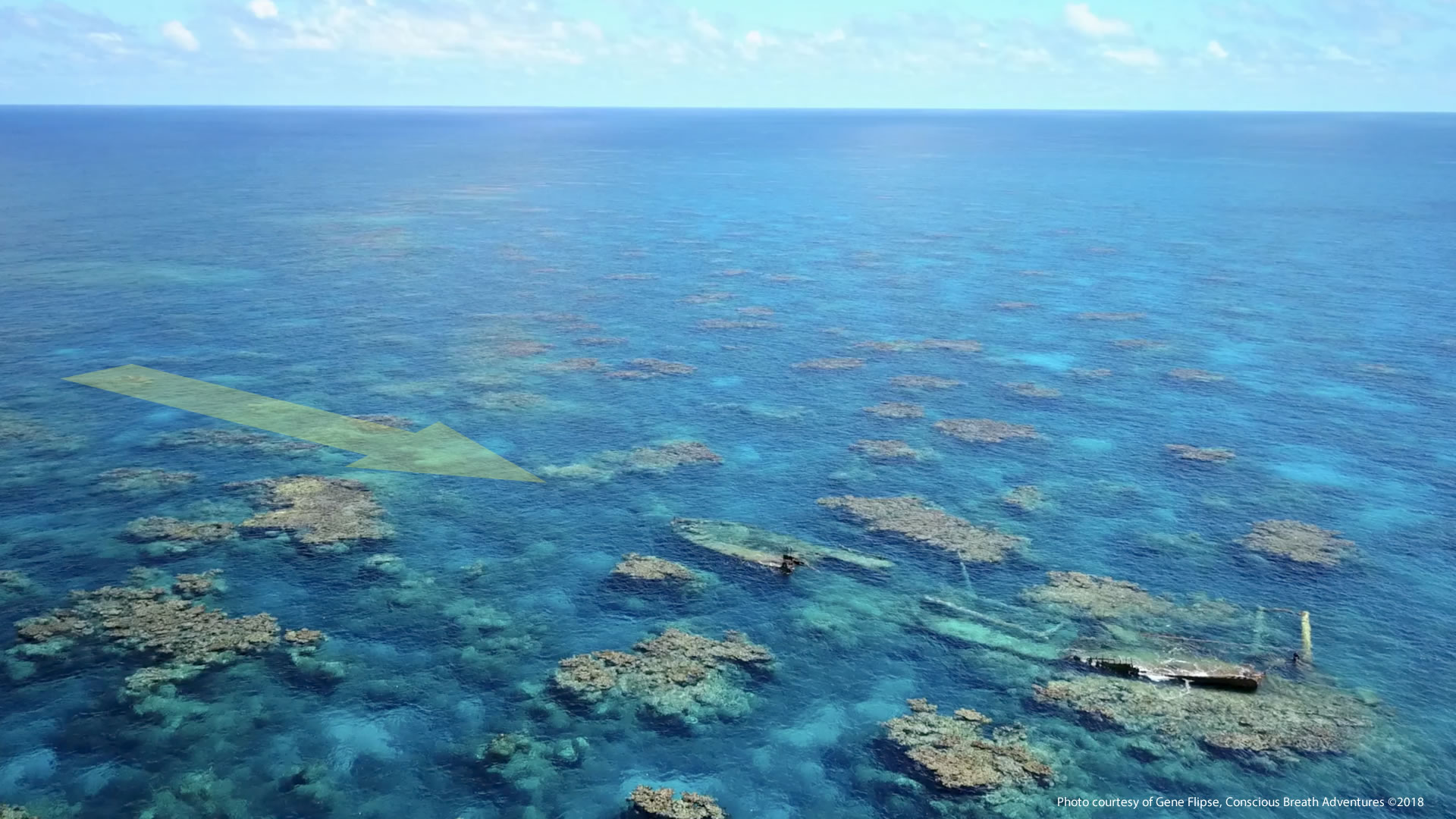Shipwrecks, Reefs, and Stories About You

Shipwrecks are the ultimate symbols of massive failure. Building and operating a ship is an enormous enterprise that requires people, money, teamwork, and skill. Whether a vessel was sunk in battle or lost to a navigational blunder, every wrecked ship had someone at the helm (or someone who should have been) when the “Oh Shit!” moment occurred. Whether it’s the Titanic or a pile of ballast stones from a Spanish galleon, shipwrecks have stories to tell. Stories are always about people, and authentic stories are about you. Shipwreck stories are no different.
The loss of a ship is no casual affair. The value of a large vessel and her cargo are significant, and yet, once a ship is irretrievably sunk or aground and the salvage efforts are finished, the years slip by and we’re left to wonder what happened. The clues to the story grow harder to find and read as marine growth and deterioration take their toll.
I first dove on the Polyxeni in 2013. Local folklore said she was a Greek freighter that went aground on the reef north of the Dominican Republic. Some said she’d been carrying an illegal cargo and was running from the Coast Guard when she struck the coral during the mid 1970s. When I was first there, much of the Polyxeni was above the water. Cargo masts and booms hung precariously, and the prospect of having one crash down at an inopportune moment kept me away from major portions of the wreck.

Shipwreck of Polyxeni, 2013
I returned to the Polyxeni five years later in April of 2018. After two Category 5 hurricanes had passed directly over her in September, 2017, not much was left above water. Anything that could have collapsed had done so, and given the unusually calm and clear conditions, I had an excellent opportunity to snorkel around and over the wreck to shoot some video footage.
The twin masts that supported the cargo booms had fallen, tearing up the steel decks. The electric winches that raised and lowered freight were still there along with an old anchor still perched on the stern. Anchor chains spilled from the submerged remains of the bow, and debris was strewn about the site. For treasure hunters, there’s a big, bronze propeller buried beneath the hull.

Shipwreck of Polyxeni, 2018
A drone photograph confirmed what we already knew: The yellow arrow indicates the path the ship took over several shallow coral heads and in between a pair of larger ones where her broken-off bow now rests. The Polyxeni was heading south at a fast enough clip to carry her up, over, and into the shallow reef. Had she been a mile farther west, she might have made it safely onto the banks, but she collided with the maze of coral heads that rise to the surface. You can see the two pairs of cargo masts from the original image lying on the deck and just ahead of and alongside the bow. That must have been one bumpy, scary ride—the only saving grace being that because she hit the shallows and didn’t sink, everyone aboard probably survived.
What about the stories? A little research shows that five ships named Polyxeni have wrecked since 1905. The name “Polyxeni” is Greek and means, “hospitable and kind to strangers.” (It comes from the Greek words poly—“many” and xeni—“strangers.”) Given her name, it’s logical to assume that the ship was of Greek origin, but she was registered under the South Korean flag. And this offers a possible explanation of why so little is known about her. Whatever records exist that might contain details of what happened when she struck the reef (in 1982, not in the 70s) are probably written in Korean and buried in some file cabinet in Asia. As for the “running from the Coast Guard” story, I doubt it. Any small vessel in pursuit would have been much faster than a loaded freighter, and they would have broken off their chase long before they got close to the reef. What likely happened is that back in the days before GPS, the Polyxeni’s navigator thought his ship was a safe distance from the coral. As with most shipwrecks, this was good old-fashioned operator error.
But an even sadder story is hidden in plain sight; the Polyxeni is not the most significant wreck on the Silver Banks. Thirty-five years ago when she went aground, that garden of coral heads rising to the surface from sixty feet of depth would have been a diver’s paradise. Today, due to ocean acidification, a complication of climate change, the coral heads are all dead. The bleached reef is home to few fish, and along with the damage done to the environment, the Dominican Republic, a poor country, lost a huge opportunity to build a lucrative dive industry. There are shipwrecks and there are shipwrecks. It is our poor navigation—the developed nations of the world’s inability to see the rocks we’re headed for—that destroyed a precious natural resource and contributed to the poverty of people who did little to bring this disaster upon themselves.
Captains of ships and captains of industry who practice careless navigation are not always so fortunate to fail in shallow waters. During the first two months of 2019, at a time when GPS, lifeboats, fire suppression systems, and other safety measures are not only commonplace but required by law, 20 shipwrecks occurred around the world.
As the years go by and the Polyxeni’s hull slowly deteriorates, there will be less and less evidence that she ever existed, but a dead coral reef tells a longer-lasting and much more serious cautionary tale about grand enterprises that are “too big to fail.” They can, they do, and they will. Stories are about people; authentic stories are about you.



Good story, well written.